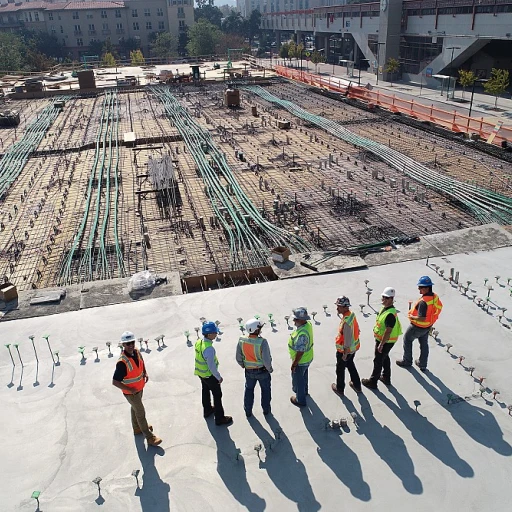Understanding Candidate Pain Points
Spotting the Bumps on the Road
Job seekers often find themselves tangled in a web of confusion during the application process. It's like trying to solve a puzzle without all the pieces. The candidate experience can sometimes feel like a never-ending maze, with hurdles that seem to pop up at every turn. Let's talk about some of these common pain points that candidates face and how they impact their journey.
First off, the application process itself can be a real headache. Many candidates report feeling frustrated when they encounter lengthy applications that require them to input the same information repeatedly. It's like being asked to fill out a form at the doctor's office for the hundredth time. This repetition not only wastes time but also leaves candidates feeling undervalued.
Then there's the issue of unclear job descriptions. Imagine being handed a map without any landmarks or directions. That's what a vague job description feels like. Candidates need clear, concise information to determine if they're the right fit for a role. Without it, they might feel like they're shooting in the dark, applying for positions that might not even align with their skills or interests.
Communication Breakdown
Another major stumbling block is the lack of communication from the employer. Candidates often feel like they're sending their applications into a black hole, never to hear back. This radio silence can be demoralizing and might even deter top talent from pursuing roles with a company. Feedback, even if it's a simple acknowledgment of receipt, can make a world of difference.
Moreover, the interview process can be a nerve-wracking experience for candidates. Unclear expectations, long waiting times, and multiple rounds of interviews can leave candidates feeling drained and unsure of their standing. It's essential for companies to streamline their recruitment process and keep candidates informed every step of the way.
Feeling Like Just Another Number
Lastly, candidates often feel like they're just another number in the system. The lack of personalization in the recruiting process can make candidates feel like their unique talents and experiences aren't being recognized. Companies need to make an effort to connect with candidates on a personal level, showing them that they're valued and appreciated.
Addressing these pain points is crucial for improving the candidate journey. By focusing on creating a user-friendly application process, providing clear job descriptions, maintaining open lines of communication, and personalizing interactions, companies can enhance their employer brand and attract qualified candidates. In the next sections, we'll explore how to streamline the application process and leverage technology to make the candidate experience smoother and more engaging.
Streamlining the Application Process
Making the Application Process Easier
Let's face it, job applications can be a hassle. But when a company takes the time to simplify this process, it can make a world of difference for candidates. A streamlined application process not only saves time but also shows that the employer values the candidate's effort. So, how can businesses make this happen?
First, it's all about clarity. Job descriptions should be clear and concise, leaving no room for guesswork. Candidates should know exactly what the role entails and what the company expects. This helps attract qualified candidates who are genuinely interested in the position.
Going Digital with Applications
In today's tech-savvy world, a user-friendly online application process is a must. Many companies are turning to digital platforms to simplify their recruitment process. This not only speeds up the application process but also makes it more accessible to job seekers. Online applications should be easy to navigate, allowing candidates to quickly upload their resumes and cover letters without jumping through hoops.
Cutting Down on Red Tape
Lengthy application processes can deter top talent. Candidates don't want to spend hours filling out forms that ask for information already included in their resumes. Streamlining this part of the process can help keep candidates engaged. Consider asking only for the essentials and providing clear instructions on what is needed at each step.
Feedback and Follow-Up
Once candidates have submitted their applications, they appreciate timely feedback. A simple acknowledgment that their application has been received can go a long way. Regular updates about their status in the hiring process can also help keep them in the loop and maintain their interest in the company.
By focusing on these areas, companies can create a more efficient and candidate-friendly application process. This not only enhances the candidate experience but also strengthens the employer brand, making the company more attractive to potential hires.
Leveraging Technology for Better Engagement
Tech's Role in the Candidate Experience
In the whirlwind of the hiring process, technology isn't just a shiny tool; it's a game-changer. Think about it: job seekers today expect a seamless, user-friendly experience. From the moment they click on a job description to the final interview, every step counts. So, how does tech fit into this puzzle?
First up, applicant tracking systems (ATS). These aren't just fancy databases. They help companies sift through applications efficiently, ensuring qualified candidates don't slip through the cracks. But remember, an ATS is only as good as its setup. If it's too complex, you might scare off talent before they even hit 'submit'.
Bridging Gaps with Automation
Automation can be your best friend. Picture this: a candidate submits their application and immediately receives a confirmation email. This simple act reassures them that their application didn't vanish into the void. It’s a small touch, but it speaks volumes about your company’s attention to detail.
Moreover, chatbots are stepping up in the recruitment process. These digital assistants can answer common questions about the job or the company, giving candidates quick responses without tying up your HR team. This not only saves time but also keeps the candidate engaged.
Social Media: The Unsung Hero
Social media isn't just for memes and cat videos. It's a powerful tool in the recruiting process. Platforms like LinkedIn and Twitter offer a glimpse into your employer brand. Share stories, highlight employee experiences, and showcase what makes your company tick. This not only attracts top talent but also builds trust with potential hires.
And let's not forget about feedback. Encourage candidates to share their experiences. Whether it's through surveys or direct feedback, this information can help refine your process. After all, a positive candidate journey reflects well on your company.
For more insights on making your job applications mobile-friendly, check out our related post.
Personalizing the Candidate Experience
Adding a Personal Touch to Recruitment
When it comes to the hiring process, one size doesn't fit all. Every candidate is unique, bringing their own skills, experiences, and expectations to the table. Personalizing the candidate experience can make a huge difference in how job seekers perceive your company and, ultimately, in attracting top talent.
Imagine you're applying for a job, and the process feels cold and impersonal. It's like sending your cover letter into a void. But when a company takes the time to personalize interactions, candidates feel valued and seen. This approach can transform the candidate journey from just another job application to a memorable experience.
Why Personalization Matters
Incorporating personalization in recruitment isn't just a nice-to-have; it's a must for companies aiming to stand out. Here's why:
- Builds a Strong Employer Brand: Personalized experiences show candidates that your company values individuals, not just their resumes. This can significantly boost your employer branding.
- Improves Candidate Engagement: When candidates feel like they're more than just a number, they're more likely to engage positively with your recruitment process.
- Reduces Drop-off Rates: A personal touch can keep candidates from abandoning their applications midway through the process.
Simple Ways to Personalize the Candidate Experience
Personalization doesn't have to be complex. Here are some practical steps companies can take:
- Tailor Communication: Use the candidate's name in emails and customize messages based on their background and interests. Avoid generic templates.
- Offer Flexible Interview Options: Allow candidates to choose interview times that fit their schedules. This flexibility shows respect for their time and commitments.
- Provide Detailed Feedback: After interviews, give constructive feedback. It helps candidates improve and shows that your company cares about their professional growth.
Real-Life Success Stories
Consider a company that revamped its recruitment process by adding personal touches. They began by sending personalized video messages to candidates who made it to the interview stage. This small change resulted in a 30% increase in positive feedback from job candidates. It's proof that even minor adjustments can have a major impact.
Another business implemented a system where hiring managers personally reached out to candidates who weren't selected, offering feedback and future opportunities. This gesture not only improved their employer brand but also turned potential negative experiences into positive ones.
Personalizing the candidate experience is about showing genuine interest in candidates as individuals. It's about making them feel valued and respected throughout the recruitment process. By doing so, companies can attract and retain qualified candidates, enhancing their overall hiring strategy.
Ensuring Transparent Communication
Building Trust Through Open Dialogue
In the hustle of the hiring process, transparent communication can be the difference between attracting top talent and losing them to competitors. When job seekers submit their applications, they often feel like they're sending them into a black hole. A simple acknowledgment email can reassure candidates that their job application has been received and is under review.Setting Clear Expectations
Imagine applying for a job and not knowing when you'll hear back. It's frustrating, right? Clear timelines and expectations can help alleviate this stress. If the recruitment process is expected to take time, let the candidates know. Regular updates, even if just to say the process is ongoing, can keep candidates engaged and reduce anxiety.Two-Way Communication
Communication shouldn't be a one-way street. Encourage candidates to ask questions about the job, the company, or the interview process. This not only helps them feel valued but also gives the employer a chance to showcase their employer brand. Remember, the interview process is as much about the candidate assessing the company as it is the company assessing the candidate.Feedback: The Gift That Keeps Giving
Providing feedback, whether positive or constructive, is a crucial part of the candidate experience. It shows that the company values the time and effort candidates put into their applications. This feedback can also help candidates improve for future opportunities, potentially turning them into future applicants or brand advocates.Leveraging Social Media for Communication
Social media platforms are not just for marketing; they can be powerful tools for communication in the recruitment process. Use these platforms to share updates about the hiring process, answer common questions, and showcase your company culture. This can help keep candidates informed and engaged, making the application process more user-friendly. Incorporating transparent communication practices into your hiring process can significantly enhance the candidate experience. By building trust and maintaining open dialogue, companies can attract and retain qualified candidates, ultimately strengthening their employer brand and improving the overall recruitment process.Measuring and Improving Candidate Experience
Keeping Tabs on the Candidate Experience
When it comes to hiring, the candidate experience isn't just a buzzword—it's a real game-changer. But how do you know if your recruitment process is hitting the mark? It's all about measuring and improving. Let's break it down.
First off, feedback is your best friend. After a candidate goes through the job application process, ask them about their experience. Were the job descriptions clear? Did they feel the interview process was fair? Gathering these insights can help you spot areas that need a little TLC.
Next, consider using metrics to track your progress. Look at things like the time it takes to fill a position, the number of qualified candidates applying, and the dropout rate during the application process. These numbers can give you a snapshot of how well your recruiting process is working.
Using Technology to Your Advantage
Don't forget about the power of technology. Applicant tracking systems can help streamline the hiring process, making it easier to manage applications and keep candidates in the loop. Plus, social media can be a great tool for promoting your employer brand and attracting top talent.
Remember, a user-friendly application process is key. If job seekers find it easy to apply, they're more likely to stick around. So, make sure your online application is straightforward and mobile-friendly.
Building Trust Through Transparency
Transparency is another biggie. Be upfront about what candidates can expect during the hiring process. Clear communication can help build trust and make job candidates feel valued. If they have questions, be ready with answers—it's all part of creating a positive candidate journey.
And let's not forget about personalizing the experience. Tailoring your approach to meet the needs of individual candidates can make a huge difference. Whether it's a personalized email or a quick follow-up call, these little touches can set your company apart.
In the end, improving the candidate experience is all about paying attention to the details. By focusing on feedback, using the right technology, and keeping communication open, you can create a recruitment process that attracts and retains the best talent.





